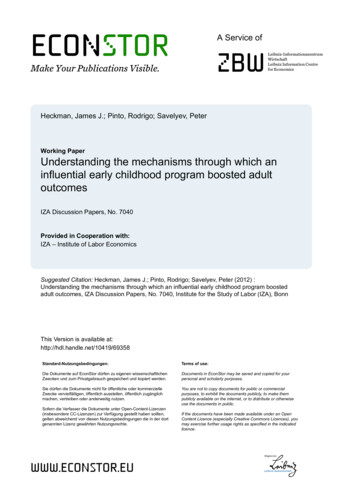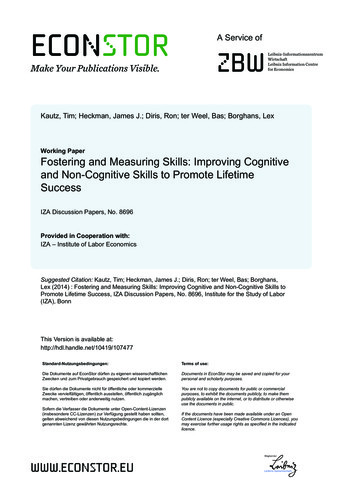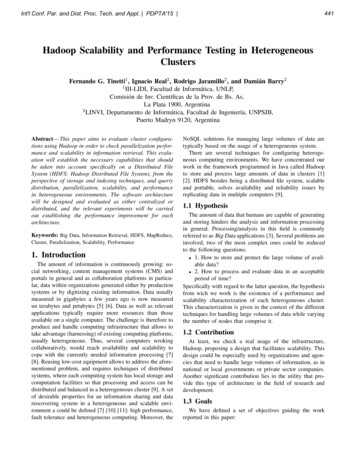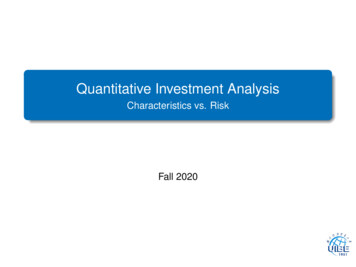
Transcription
econstorA Service ofzbwMake Your Publications iz Information Centrefor EconomicsHeckman, James J.; Pinto, Rodrigo; Savelyev, PeterWorking PaperUnderstanding the mechanisms through which aninfluential early childhood program boosted adultoutcomesIZA Discussion Papers, No. 7040Provided in Cooperation with:IZA – Institute of Labor EconomicsSuggested Citation: Heckman, James J.; Pinto, Rodrigo; Savelyev, Peter (2012) :Understanding the mechanisms through which an influential early childhood program boostedadult outcomes, IZA Discussion Papers, No. 7040, Institute for the Study of Labor (IZA), BonnThis Version is available ngsbedingungen:Terms of use:Die Dokumente auf EconStor dürfen zu eigenen wissenschaftlichenZwecken und zum Privatgebrauch gespeichert und kopiert werden.Documents in EconStor may be saved and copied for yourpersonal and scholarly purposes.Sie dürfen die Dokumente nicht für öffentliche oder kommerzielleZwecke vervielfältigen, öffentlich ausstellen, öffentlich zugänglichmachen, vertreiben oder anderweitig nutzen.You are not to copy documents for public or commercialpurposes, to exhibit the documents publicly, to make thempublicly available on the internet, or to distribute or otherwiseuse the documents in public.Sofern die Verfasser die Dokumente unter Open-Content-Lizenzen(insbesondere CC-Lizenzen) zur Verfügung gestellt haben sollten,gelten abweichend von diesen Nutzungsbedingungen die in der dortgenannten Lizenz gewährten Nutzungsrechte.www.econstor.euIf the documents have been made available under an OpenContent Licence (especially Creative Commons Licences), youmay exercise further usage rights as specified in the indicatedlicence.
SERIESPAPERDISCUSSIONIZA DP No. 7040Understanding the Mechanisms Through Which anInfluential Early Childhood Program BoostedAdult OutcomesJames HeckmanRodrigo PintoPeter SavelyevNovember 2012Forschungsinstitutzur Zukunft der ArbeitInstitute for the Studyof Labor
Understanding the Mechanisms ThroughWhich an Influential Early ChildhoodProgram Boosted Adult OutcomesJames HeckmanUniversity of Chicago, University College Dublin,American Bar Foundation and IZARodrigo PintoUniversity of ChicagoPeter SavelyevVanderbilt University,RWJF Center for Health Policy, Meharry Medical CollegeDiscussion Paper No. 7040November 2012IZAP.O. Box 724053072 BonnGermanyPhone: 49-228-3894-0Fax: 49-228-3894-180E-mail: iza@iza.orgAny opinions expressed here are those of the author(s) and not those of IZA. Research published inthis series may include views on policy, but the institute itself takes no institutional policy positions.The IZA research network is committed to the IZA Guiding Principles of Research Integrity.The Institute for the Study of Labor (IZA) in Bonn is a local and virtual international research centerand a place of communication between science, politics and business. IZA is an independent nonprofitorganization supported by Deutsche Post Foundation. The center is associated with the University ofBonn and offers a stimulating research environment through its international network, workshops andconferences, data service, project support, research visits and doctoral program. IZA engages in (i)original and internationally competitive research in all fields of labor economics, (ii) development ofpolicy concepts, and (iii) dissemination of research results and concepts to the interested public.IZA Discussion Papers often represent preliminary work and are circulated to encourage discussion.Citation of such a paper should account for its provisional character. A revised version may beavailable directly from the author.
IZA Discussion Paper No. 7040November 2012ABSTRACTUnderstanding the Mechanisms Through Which an InfluentialEarly Childhood Program Boosted Adult Outcomes *A growing literature establishes that high quality early childhood interventions targetedtoward disadvantaged children have substantial impacts on later life outcomes. Little isknown about the mechanisms producing these impacts. This paper uses longitudinal data oncognitive and personality traits from an experimental evaluation of the influential PerryPreschool program to analyze the channels through which the program boosted both maleand female participant outcomes. Experimentally induced changes in personality traitsexplain a sizable portion of adult treatment effects.JEL Classification:Keywords:I21, I28, I29, J13, J15, J16, J24, O15cognitive traits, personality traits, externalizing behavior, academic motivation,factor analysis, human capital, human development, early childhoodinterventions, social experiments, Perry Preschool program, experimentallyestimated production functionsCorresponding author:James J. HeckmanDepartment of EconomicsUniversity of Chicago1126 E. 59th StreetChicago, IL 60637USAE-mail: jjh@uchicago.edu*We thank the editor, Robert Moffit, and three anonymous referees for helpful comments. Lena Malofeeva, thenat the HighScope Foundation, worked with us in supplying the Perry data and interpreting it for us. We are deeplygrateful for her assistance and the cooperation of the HighScope Foundation. Versions of this paper werepresented at numerous conferences and seminars starting in 2006 that are listed in the Web Appendix. We thankparticipants at these meetings for useful comments. We are grateful to Clancy Blair, Dan Benjamin, MartinBrowning, Sarah Cattan, Kenneth Dodge, Angela Duckworth, Amy Finklestein, Miriam Gensowski, MattGentzkow, Maryclare Griffen, Jeff Grogger, Emir Kamenica, Costas Meghir, Jörn-Steffen Pischke, Devesh Raval,Brent Roberts, Cullen Roberts, Tino Sanandaji, Larry Schweinhart, Sandra Waxman, Ben Williams, and Junjian Yifor helpful comments. The paper was presented at a Public Policy and Economics Seminar at the Harris School,University of Chicago, October, 2009, attended by Diane Schatzenbach. We are grateful to Christopher Hansman,Kegon Tan Teng Kok, Min Ju Lee, Xiliang Lin, Yun Pei, and Ivana Stosic for excellent research assistance. Thisresearch was supported in part by the American Bar Foundation, the JB & MK Pritzker Family Foundation, SusanThompson Buffett Foundation, NICHD R37HD065072, R01HD54702, a grant to the Becker Friedman Institute forResearch and Economics from the Institute for New Economic Thinking (INET), and an anonymous funder. Weacknowledge the support of a European Research Council grant hosted by University College Dublin,DEVHEALTH 269874. The views expressed in this paper are those of the authors and not necessarily those ofthe funders or persons named here. Supplementary materials are placed in a Web Appendix(http://jenni.uchicago.edu/Perry/).
1.IntroductionA growing literature establishes that early childhood environments substantially impact later life outcomes (e.g., Knudsen et al., 2006, Heckman, 2008 andAlmond and Currie, 2011). Less is known about the channels through which earlyenvironments operate to produce their long term effects. This paper examines thesources of the success of the Perry Preschool program, a flagship early childhoodintervention in the US.1The Perry program was a randomized trial that targeted disadvantaged, lowIQ African American children ages 3-4. After two years, all participants left theprogram and entered the same public school. Data were collected for treatmentand control groups through age 40.Heckman et al. (2010a) and Conti et al. (2012) show that the Perry programsignificantly enhanced adult outcomes including education, employment, earnings,marriage, and participation in healthy behaviors, and reduced participation incrime.2 We summarize many of these findings in Table 1. All treatment effectsdisplayed there are statistically significant and survive adjustments for multiplehypothesis testing.3 Heckman et al. (2010b) show that the internal rate of returnto the program for both boys and girls is a statistically significant 6–10 percentper year—above the historical return to equity.4 Positive effects of the Perryprogram have become a cornerstone of the argument for preschool programs (e.g.,Shonkoff and Phillips, 2000). Currently, about 30 percent of all Head Start centersnationwide offer a version of the Perry curriculum (ICPSR, 2010).5Previous studies of Perry focus on estimating treatment effects and do notattempt to explain their sources.6 This paper identifies the psychological skillschanged by the Perry program and decomposes the treatment effects on adultoutcomes displayed in Table 1 into components attributable to improvements inthese skills.1 The formal name of the program is the “HighScope Perry Preschool Program” (see Schweinhartet al., 2005).2 The small sample size of the Perry experiment (123 participants) has led some researchers to questionthe validity and relevance of its findings (e.g., Herrnstein and Murray, 1994, and Hanushek and Lindseth,2009). Heckman et al. (2010a) use a method of exact inference that is valid in small samples. They findthat Perry treatment effects remain statistically significant even after accounting for multiple hypothesistesting and compromised randomization.3 One of the outcomes, the number of felony arrests for males at age 27, is borderline statisticallysignificant at the 10% level.4 The historical post-World War II stock market rate of return to equity is 5.8 percent (DeLong andMagin, 2009).5 Although not necessarily with the same quality of staff and background of participants as in theoriginal program.6 See Weikart (1967); Weikart, Bond and McNeil (1978); Berrueta-Clement et al. (1984); Schweinhart,Barnes and Weikart (1993).2
The literature in the economics of education assumes the primacy of cognitiveability in producing successful lifetime outcomes (e.g., Hanushek and Woessmann,2008). From this perspective, the success of the Perry program is puzzling. Although the program initially boosted the IQs of participants, this effect soonfaded. A few years after the program finished, there was no statistically significant difference in IQ between treatments and controls for males and only aborderline statistically significant difference for females (see Figure 1). Consistent with this evidence, we show negligible effects of increases in IQ in producingprogram treatment effects.Although Perry did not produce long run gains in IQ, it did create persistent improvements in personality skills.7 The Perry program substantially improved Externalizing Behaviors (aggressive, antisocial, and rule-breaking behaviors), which,in turn, improved a number of labor market outcomes, health behaviors, andcriminal activities (see panels (a) and (b) of Figures 2 and 3).8The program also enhanced Academic Motivation (see panels (c) and (d) ofFigures 2 and 3), but the effect is primarily for girls.9 This differential enhancement of endowments by gender helps to explain the positive treatment effects foreducation-related outcomes such as achievement tests and mental impairment forgirls. Academic Motivation is not significantly enhanced for boys, and plays norole in explaining their treatment effects.While the Perry program did not boost long-term IQ, it did boost long-termachievement test scores (see panels (e) and (f) of Figures 2 and 3). The effect isstronger for girls, but also occurs for boys.10 Achievement tests measure acquiredknowledge, which is enhanced for children with better cognitive and personality traits. Enhanced personality skills promote learning, which, in turn, boostsachievement test scores.11 This finding is consistent with recent evidence that 30–40 percent of the explained variance in achievement test scores across students isdue to personality traits and not IQ.12 .This paper contributes to an emerging literature on the economics of personality. Our demonstration of the powerful role of personality skills is in agreementwith a large body of evidence summarized in Borghans et al. (2008) and Almlundet al. (2011).137 SeeHeckman (2000) and Carneiro and Heckman (2003).in crime is a major benefit of the Perry program (Belfield et al., 2006; Heckman et al.,8 Reduction2010b).9 See Figure C.7 of the Web Appendix for breakdowns by gender.10 See Figure B.5 in the Web Appendix.11 See Cunha and Heckman (2008) and Cunha, Heckman and Schennach (2010) for evidence thatpersonality traits boost acquisition of cognition as measured by achievement tests.12 Borghans et al. (2011a) show that achievement test scores are explained, in part, by both personalitytraits and IQ. See also Heckman and Kautz (2012)13 See also Bowles and Gintis (1976, 2001); Heckman, Stixrud and Urzúa (2006); Segal (2008, 2009).3
Our analysis shows the benefits and limitations of social experiments. ThePerry study generated experimentally determined treatment effects for outcomesand skills. However, knowledge that the program enhanced skills and improved anumber of outcomes is not enough to establish that the improvement in measuredskills caused the improvement in outcomes. Without further assumptions, datafrom the experiment do not determine the production function relating changesin skills to changes in adult outcomes. The program may also improve unmeasured skills. Changes in measured skills may simply proxy changes in unmeasuredskills that affect outcomes. To address this issue, we supplement the treatmenteffects obtained from the experiment with an econometric model that estimatesthe relationship between outcomes and experimentally induced changes in measured skills. Our method accounts for measurement error and treatment-inducedchanges in unmeasured skills. Access to experimental data allows us to test someof its identifying assumptions. Evidence from a series of specification tests supports our econometric procedure.The paper proceeds in the following way. Section 2 describes the Perry program and the experiment that evaluated it. Section 3 presents our econometricmodel. Section 4 discusses the variety of measures of psychological traits at ourdisposal and the need to create low-dimensional summaries of them. It explainshow we construct summary measures and test for the validity of the constructedsummaries. Section 5 presents our analysis of the sources of the Perry treatmenteffects. Section 6 concludes. A Web Appendix presents supplementary material.2.The Perry Program: Design and BackgroundThe Perry program targeted African American children with low IQs and socioeconomic status (Schweinhart and Weikart, 1981). The experiment was conductedduring the mid-1960s in the district of the Perry elementary school in Ypsilanti,Michigan. Children began the program at age three and were enrolled for twoyears.14 Parents were disadvantaged as measured by their income and education.Roughly 47 percent of the children in the study did not have fathers present inthe household at age three.The 123 participants were randomized into treatment and control groups.15The Perry sample consists of 51 females (25 treatment and 26 control) and 72males (33 treatment and 39 control). There was relatively little attrition: only11 participants left the study by the time of the interview at age 40.1614 Thefirst entry cohort was enrolled for only one year of the program, beginning at age four.et al. (2010a) describe the protocol and develop statistical procedures for testing treatmenteffects which take into account the peculiarities of the Perry randomization protocol.16 Five control and two treatment group participants died; two control and two treatment group participants were missing.15 Heckman4
The Perry curriculum is based on the principle of active participatory learning,in which children and adults are treated as equal partners in the learning process,and children engage with objects, people, events, and ideas.17 Abilities to plan,execute, and evaluate tasks were fostered, as were social skills, including cooperation with others and resolution of interpersonal conflicts. The Perry curriculumhas been interpreted as implementing the theories of Lev Vygotsky (1986) inteaching self control and sociability.18 A widely implemented program based onthese principles — Tools of the Mind — is designed to promote self control.19Sessions lasted 2.5 hours and were held five days a week during the schoolyear. Teachers in the program, all of whom had bachelor’s degrees (or higher) ineducation, made weekly 1.5-hour home visits to treatment group mothers withthe aim of involving them in the socioemotional development of their children.The control group had no contact with the Perry program other than throughannual testing and assessment (Weikart, Bond and McNeil, 1978).Perry predates Head Start and had no competitors, so there was no controlgroup contamination (see Schweinhart and Weikart, 1981). All eligible parentsenrolled their children in the program, so there was no issue of bias arising fromnoncompliance (Weikart, Bond and McNeil, 1978).Numerous measures were collected annually from ages 3–15 on a variety of socioeconomic outcomes for treatment and control participants. There were threeadditional follow-ups at ages 19, 27, and 40. The Perry sample was representative of a particularly disadvantaged cohort of the African American population.About 16 percent of all African American children in the US had family andpersonal attributes similar to those of Perry participants at the time when thePerry program was conducted.20 The statistically significant treatment effectsof the experiment for boys and girls survive rigorous adjustments for multiplehypothesis testing and compromises in the randomization protocol.2117 SeeWeb Appendix A for more information on the Perry curriculum.curriculum of the Perry program was also grounded, in part, in the research on cognitivedevelopment by Jean Piaget (Piaget and Inhelder, 2000) and in the progressive educational philosophyof John Dewey (Dewey, 1997).19 See Tough (2009) for a popular exposition of the Tools of the Mind program. See Bodrova and Leong(2007) for a complete description of the Tools of the Mind program. Diamond et al. (2007) present arecent evaluation of the program that demonstrates that it enhanced self-control by participants. For adiscussion of the Vygotskian foundations of the Perry program see Sylva (1997).20 Heckman et al. (2010a).21 Anderson (2008) adjusts test statistics for the Perry program treatment effects for the effects ofmultiple hypothesis testing. He claims that the program only affected girls. Heckman et al. (2010a)critically evaluate this conclusion and his procedures. They establish statistically significant programtreatment effects for both boys and girls. Heckman et al. (2010b) show that the rate of return to theprogram is statistically significantly different from zero for both boys and girls.18 The5
3.MethodologyThis paper explains the sources of the Perry treatment effects in terms of improvements in early measures of psychological traits broadly classified into cognitive and personality skills.22 We first estimate treatment effects for these skills.We then estimate the relationship between skills and later life outcomes and decompose treatment effects for adult outcomes into components due to treatmentinduced changes in different skills.23To perform valid decompositions, we need to address two features of the Perrydata. First, as previously noted, the randomized design of the Perry study allowsus to identify the causal effect of the treatment on measured skills and on adultoutcomes, but it does not directly allow us to identify the causal effect of increasesin measured skills on outcomes. We use econometric methods to address thisproblem. Using experimental variation, we can be more confident in the validityof our decompositions because we can test some of the assumptions maintained inour procedure. However, it is necessary to maintain some exogeneity assumptionsin order to construct valid decompositions. This section makes those assumptionsexplicit.Second, the Perry study has many highly correlated measurements of psychological traits (skills) that are laden with measurement error.24 Moreover, thesample size of the study is small. We would exhaust the available degrees offreedom if we use all available psychological measurements to predict outcomes.Instead, we use factor analysis to create low dimensional, interpretable and informative aggregates that summarize a range of psychological traits and accountfor measurement error.Section 3.3.1 presents our model for outcomes. Section 3.3.2 presents our strategy for reducing numerous error-laden measurements to manageable summary22 Throughout the paper we assume that the Perry program has either positive or no effect on outcomesand use one sided p-values to test hypotheses. The literature shows that high-quality intervention programs targeting disadvantaged children generally show either beneficial or no effects from the program.For example, Gray and Klaus (1970), Lazar et al. (1982), Campbell and Ramey (1994, 1995), Yoshikawa(1995), and Reynolds et al. (2001) document beneficial effects of intervention programs targeting disadvantaged children. Barnett (1995) reviews a variety of early intervention programs and shows thatthere were mainly beneficial effects on children’s development outcomes, although some programs had notreatment effects. He explains the lack of treatment effects as a consequence of the difference in programquality. Baker, Gruber and Milligan (2008) investigate the effects of Quebec’s universal childcare program and find a number of adverse effects of this program on children’s socio-emotional skills, possiblycasting doubt on use of one-sided p-values in this paper. The program they study is a warehousing childcare program, not a high quality early intervention program. Ramey and Ramey (2010) show that lowquality childcare program can have adverse effects. The Perry program was of extremely high quality andtargeted highly disadvantaged children who generally lacked adequate parenting. Therefore, we shouldexpect positive or no effects from the program.23 These are called mediation analyses in the statistics literature. See, e.g., Pearl (2011). Such analyseshave been used for decades in economics. See, e.g., Klein and Goldberger (1955) and Theil (1958).24 For evidence on the extent of measurement error in these traits see Cunha and Heckman (2008) andCunha, Heckman and Schennach (2010).6
measures and addressing the problem of measurement error. Section 3.3.3 discusses identification. We establish what features of the model are overidentified,and hence testable. Section 3.3.4 summarizes a simple and robust three-stepestimation procedure that is developed more extensively in the appendix.3.1.The Outcome EquationLet D denote treatment assignment. D 1 if an agent is treated and D 0otherwise. Let Y1 and Y0 be the counterfactual outcomes when D is fixed at “1”and “0” respectively. We use the subscript d {0, 1} to represent variables whentreatment is fixed at d. Fixing corresponds to manipulating treatment status dholding everything else constant.25 The observed outcome is(1)Y DY1 (1 D)Y0 .We assume that outcomes are independent across participants conditional onobserved pre-program variables X that are assumed not to be affected by theprogram. We introduce the notion of skills that can be changed by the programand that they produce (in part) the treatment effect. The vector of skills whentreatment is fixed at d is given by θd (θdj : j J ), where J is an index set forskills. We define θ in a fashion analogous to Y : θ Dθ1 (1 D)θ0 .Our analysis is based on the following linear model:(2)Yd κd αd θd βd X d , d {0, 1},where κd is an intercept, αd and βd are, respectively, J -dimensional and X dimensional vectors of parameters where Q denotes the number of elements inQ. While the pre-program variables X are assumed not to be affected by thetreatment, their effect on Y can be affected by the treatment. d is a zero-meanerror term assumed to be independent of regressors θd and X.Perry analysts collected a rich array of measures of cognitive and personalityskills. However, it is very likely that there are relevant skills that they did notmeasure. Notationally, let Jp J be the index set of skills on which we havemeasurements. The measurements may be imperfect so even these skills maynot be directly observed. We decompose the term αd θd in equation (2) into25 The distinction between fixing and conditioning traces back to Haavelmo (1943). See Pearl (2009)and Heckman and Pinto (2012a) for recent discussions.7
components due to skills we measure and skills we do not:X j j(3)Yd κd αd θd βd X dj J κd Xαdj θdjX j Jp τd {zαj θdj βd X dj J \Jp} {z}skills on which weskills on which wehave measurementshave no measurementsX j jαd θd βd X d ,j JpPwhere d {0, 1}, τd κd j J \Jp αdj E(θdj ), and d is a zero-mean error termPdefined by d d j J \Jp αdj (θdj E(θdj )). Any differences in the error termsbetween treatment and control groups can be attributed to differences in the skillson which we have no measurements. Without loss of generality we assume thatdistdist 1 0 , where means equality in distribution. Note that the error term d is correlated with the measured skills if measured skills are correlated withunmeasured skills.We seek to decompose treatment effects into components attributable to changesin the skills that we can measure. Assuming that changes in unmeasured skillsattributable to the experiment are independent of X, treatment effects can bedecomposed into components due to changes in skills E( θj ) and componentsdue to changes in parameters αj ( α1j α0j ):(4)E( Yd X) E(Y1 Y0 X) (τ1 τ0 ) E X α1j θ1j α0j θ0j (β1 β0 ) Xj Jp (τ1 τ0 ) X E αj α0j E θj αj E θ0j j Jp (β1 β0 )X.26Equation (4) can be simplified if treatment affects skills, but not the impactof skills and background variables on outcomes, i.e. α1j α0j ; j Jp and β1 26 Alternativedecompositions are discussed in Appendix E.38
β0 .27 Under the latter assumption, the term associated with X drops from thedecomposition.We establish below that if measured and unmeasured skills are independentin the no-treatment outcome equation, α0 can be consistently estimated by astandard factor analysis. Under this assumption, and if α1 α0 , we can testif the experimentally-induced increments in unmeasured skills are independentof the experimentally induced increments in measured skills.28 The intuitionfor this test is as follows. The skills for treated participants are the sum of theskills they would have had if they were assigned to the control group plus theincrement due to treatment. If measured and unmeasured skill increments areindependent, α1 is consistently estimated by a standard factor analysis and we cantest if plim α̂1 plim α̂0 where (α̂0 , α̂1 ) are estimates of (α0 , α1 ).29 Assumingthe exogeneity of X, we can also test if plim β̂1 plim β̂0 , where (β̂0 , β̂1 ) areestimates of β0 and β1 . We test and do not reject these hypotheses.Imposing these assumptions simplifies the notation. Equation (3) may be expressed asXαj θdj βX d , d {0, 1}.(5)Yd τd j JpIn this notation, equation (1) becomesXX(6) Y D (τ1 αj θ1j βX 1 ) (1 D) (τ0 αj θ0j βX 0 )j Jp τ0 τ D j Jp{zY1X} {zY0}αj θj βX ,j Jpwhere τ τ1 τ0 is the contribution of unmeasured variables to mean treatmenteffects, D 1 (1 D) 0 is a zero-mean error term, and θj Dθ1j (1 D)θ0j , j Jp denote the skills that we can measure.If the θj , j Jp , are measured without error and are independent of the errorterm , least squares estimators of the parameters of equation (6) are unbiased27 These are called structural invariance or autonomy assumptions in the econometric literature. See,e.g., Hurwicz (1962). These assumptions do not rule out heterogenous responses to treatment becauseθ1 θ0 may vary in the population.28 See Appendix J for details.29 If skill increments are not independent, then in general even if α α , plim α 6 plim α . This1010test is valid in general even when α0 cannot be consistently estimated. See Appendix J. A distinct test ofautonomy (H0 : α1 α0 ) is possible if we maintain full exogeneity (i.e. measured skills are independentof unmeasured skills in both treatment regimes).9
for αj , j Jp .30 If, on the other hand, the unmeasured skills are correlatedwith both measured skills and outcomes, least squares estimators of αj , j Jp ,are biased and capture the effect of changes in the unmeasured skills as they areprojected onto the measured components of θ, in addition to the direct effects ofchanges in measured components of θ on Y .Equation (6) is the basis for the decompositions reported in this paper. Thetreatment effect isXE(Y1 Y0 ) (τ1 τ0 ) αj E(θ1j θ0j ) .(7) {z }j Jp {z}treatment effect dueto unmeasured skillstreatment effect dueto measured skillsSkill j can explain treatment effects only if it affects outcomes (αj 6 0) and, onaverage, is affected by the experiment (E(θ1j θ0j ) 6 0). We test both conditions.Decomposition (7) would be straightforward to identify if the measured variables are independent of the unmeasured variables, and the measurements areaccurate. The second term of (7) is easily constructed by using consistent estimates of the αj and the effects of treatment on skills. However, psychologicalmeasurements are riddled with measurement error (Cunha and Heckman, 2008).In addition, there are a large number of highly intercorrelated psychological measures that need to be condensed. We address these problems in this paper.3.2.Low-Dimensional Characterizations of SkillsOne way to summarize the psychological measures is to form simple unweightedindices constructed by taking averages of interpretable groups of items. Thisway of proceeding is widely used in psy
and control groups through age 40. Heckman et al.(2010a) andConti et al.(2012) show that the Perry program signi cantly enhanced adult outcomes including education, employment, earnings, marriage, and participation in healthy behaviors, and reduced participation in crime.2 We summa










